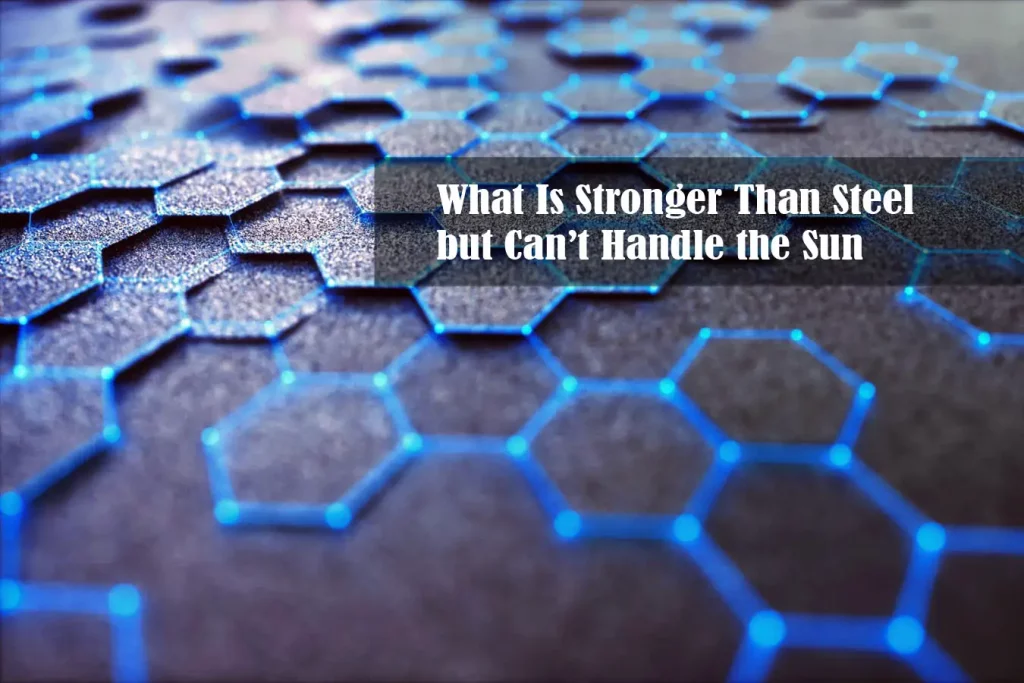Have you ever pondered the question, “what is stronger than steel but can’t handle the sun?”
It’s a riddle that delves into the fascinating world of advanced materials science.
This intriguing conundrum encapsulates the paradox of a truly revolutionary material – strong yet vulnerable.
Join us as we unravel the mystery of this extraordinary substance that is challenging our perceptions of strength and vulnerability.
Unveiling the Mystery: A Material Beyond Steel
You may have found yourself wondering, “what is stronger than steel but can’t handle the sun?” That’s a puzzling question, right? Well, not as much as you’d think! The material you’re thinking of is graphene. This wonder substance has exceptional properties, making it an exciting focus for scientists and engineers alike.
What is Steel?
Before we delve into the world of graphene, it’s essential to grasp what steel is and why it’s considered a benchmark for strength.
Steel is an alloy primarily made up of iron, with a small percentage of carbon, typically around 2%. It’s known for its strength, durability, and versatility. Steel has been the backbone of human industrial development for centuries, from the skyscrapers that kiss our city skylines to the cars we drive every day.
Properties of Steel
Steel has impressive mechanical properties that make it a go-to material for various applications. It’s tensile, it’s strong, and it’s tough. Its resistance to bending, stretching, and compression makes it ideal for structures and vehicles. Plus, it’s pretty good at dealing with temperature extremes and exposure to sunlight, which brings us to our fascinating challenger, graphene.
The Contender: Graphene
Graphene is no ordinary material. Its discovery in 2004 led to a Nobel Prize in Physics in 2010, a testament to its extraordinary potential.
Understanding Graphene
To put it simply, graphene is a single layer of carbon atoms arranged in a two-dimensional honeycomb lattice. Imagine a sheet of carbon so thin that it’s considered two-dimensional – that’s graphene.
Properties of Graphene
Now, hold onto your hats because graphene’s properties are nothing short of mind-blowing. It’s ultra-light, yet incredibly durable. And it’s about 200 times stronger than steel by weight. It’s also the thinnest compound known to man. This strength and thinness make it an incredible conductor of heat and electricity.
Why is Graphene Stronger than Steel?
The Science Behind the Strength
Why exactly is graphene stronger than steel? It all boils down to the atomic bonds and structure. The carbon atoms in graphene are sp2 hybridized – meaning they form a robust covalent bond. This bond, combined with the two-dimensional honeycomb lattice, provides graphene with its phenomenal strength.
But Why Can’t Graphene Handle the Sun?
Despite its superior strength, graphene does have a surprising Achilles’ heel – it can’t handle the sun, more specifically, ultraviolet (UV) radiation.
The Limitations of Graphene
While graphene may be the Superman of materials in terms of strength, it’s more like a vampire when it comes to the sun.
Graphene and Ultraviolet Radiation
When exposed to UV radiation, graphene undergoes a process known as photo-oxidation. This process breaks down the strong carbon bonds in graphene, causing it to lose its impressive properties. While graphene itself is stable under sunlight, the UV rays can excite the electrons, leading to the creation of reactive oxygen species, which can oxidize and break down graphene.
Current Uses and Future Prospects of Graphene
Despite its sensitivity to UV radiation, graphene is still making waves in various fields. It’s being used in electronics for its amazing electrical conductivity, in composites for its strength, and in batteries and supercapacitors for its high electron mobility.
However, the full potential of graphene is yet to be unleashed. With ongoing research, we might just be on the verge of a graphene age. From bulletproof armor to ultralight spacecraft, from water purification to medicine, the possibilities are vast and thrilling.
Safety Considerations when Working with Graphene
As with any material, it’s crucial to handle graphene with care. While it’s generally safe, it can potentially be harmful if inhaled or ingested. Therefore, protective measures should be taken when working with graphene, especially in its powdered form.
FAQs About What is Stronger Than Steel but Can’t Handle the Sun
Why is Graphene stronger than steel?
Why can't Graphene handle the sun?
Are there any safety considerations when working with Graphene?
What are some potential applications of Graphene?
Is Graphene currently in use?
Final Words
So, there you have it! The answer to “what is stronger than steel but can’t handle the sun?” is graphene. This extraordinary material is bursting with potential. Even though it’s not a fan of the sun, its remarkable properties make it a compelling area of study and innovation. With more research and technological advancements, who knows what we’ll achieve with this wonder material in the future!
Read next: What to Wear When Camping in Hot Weather


